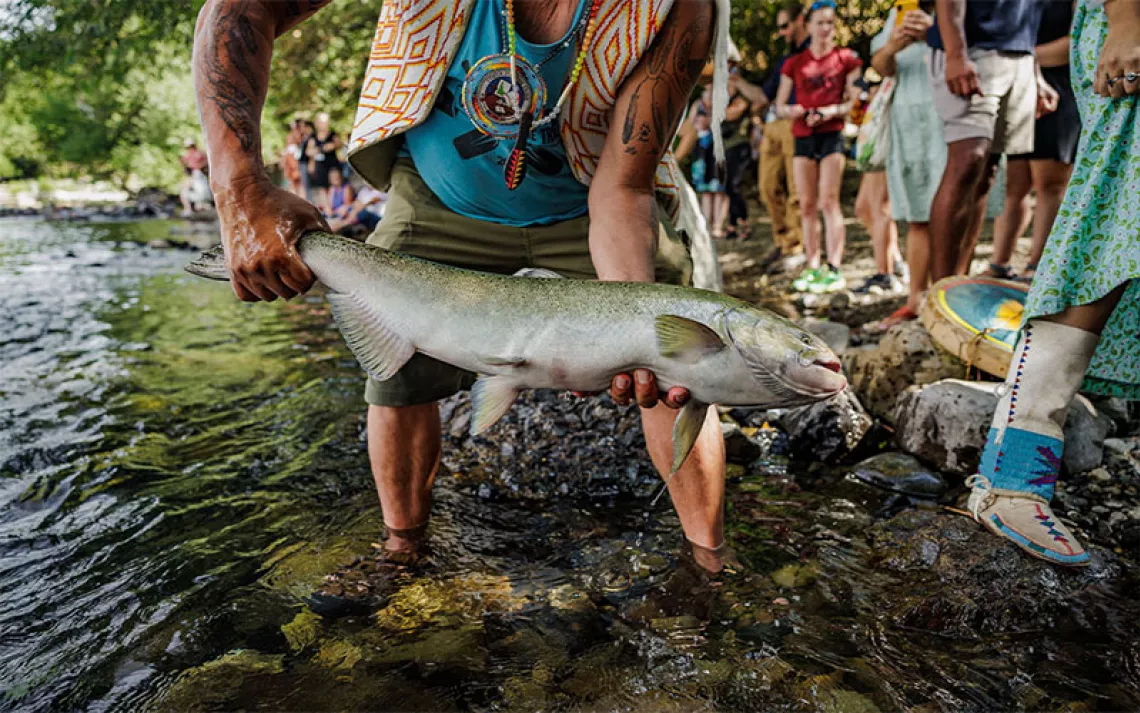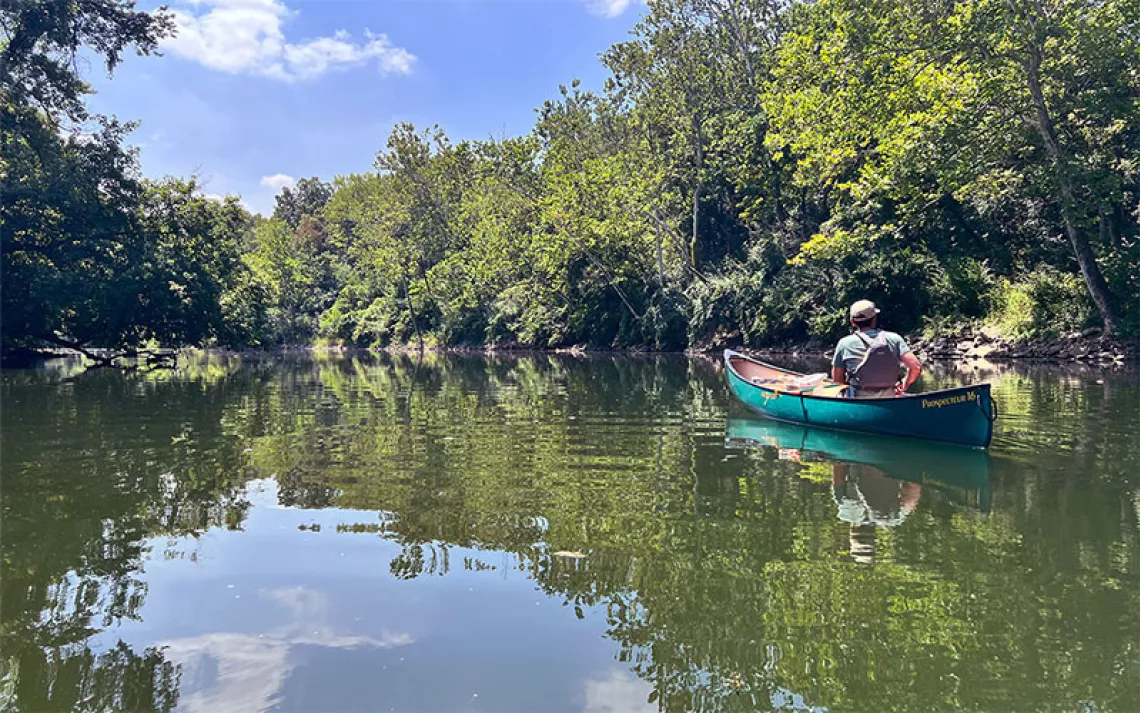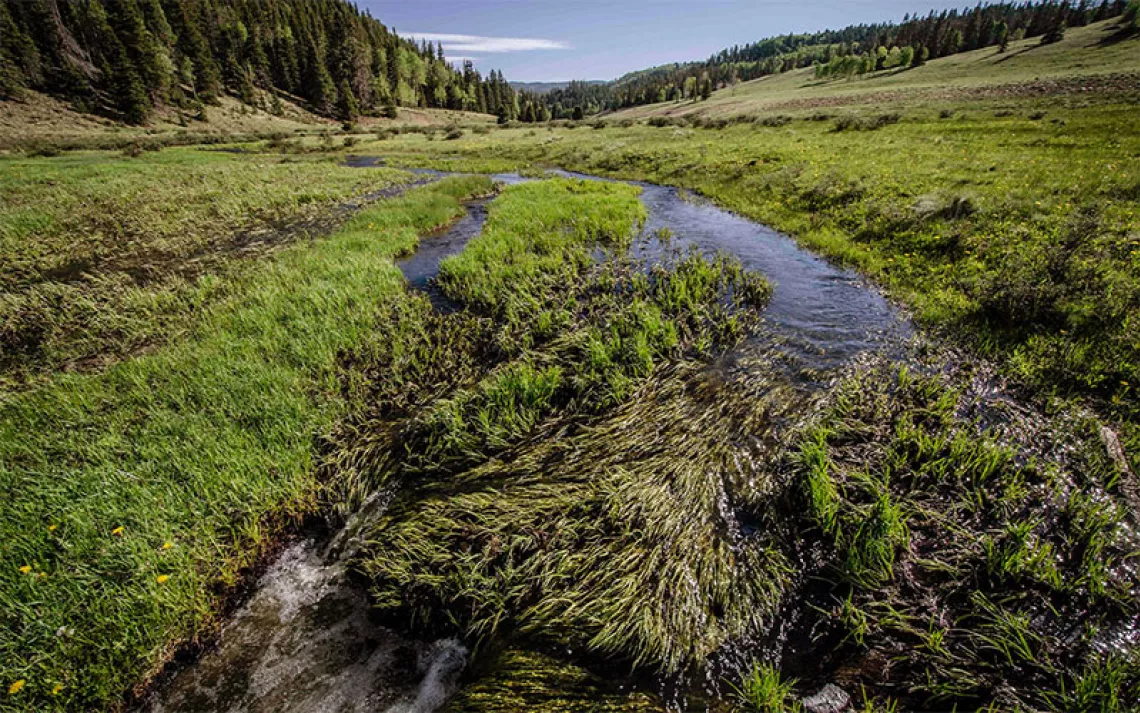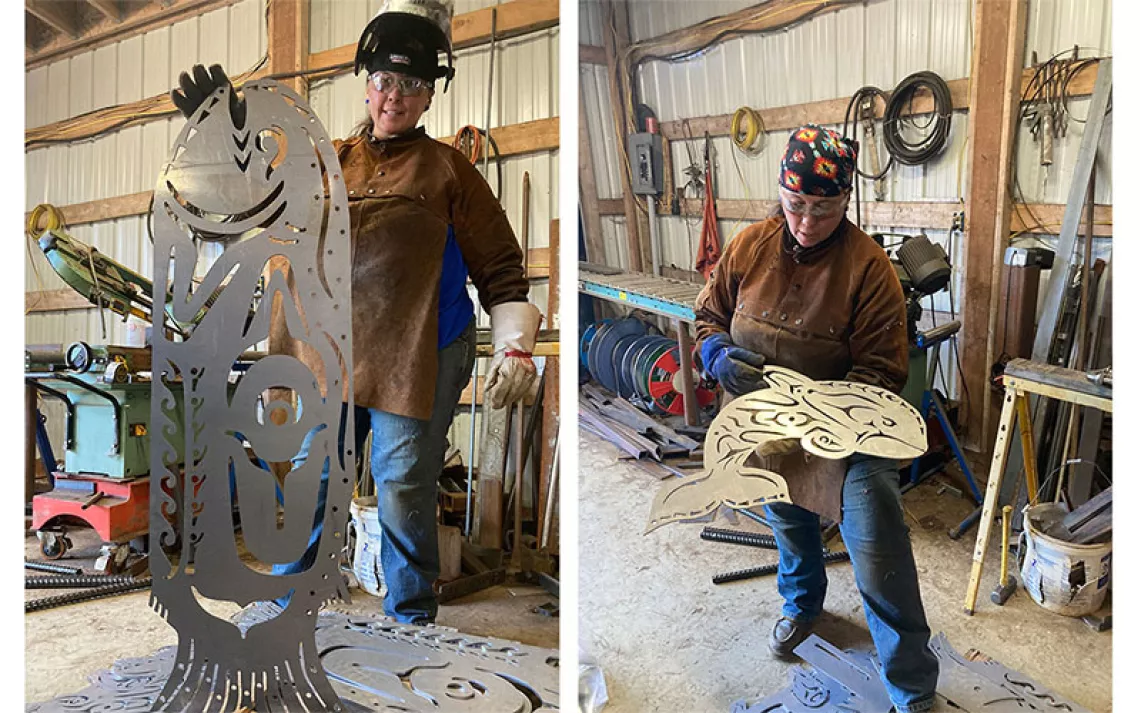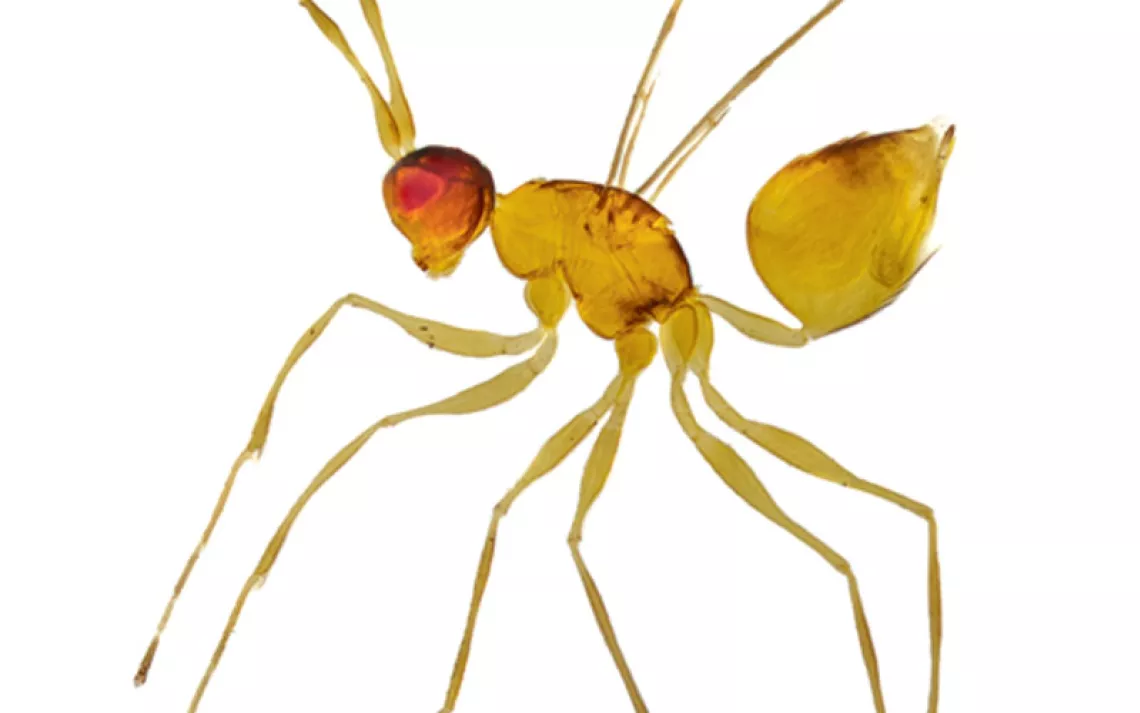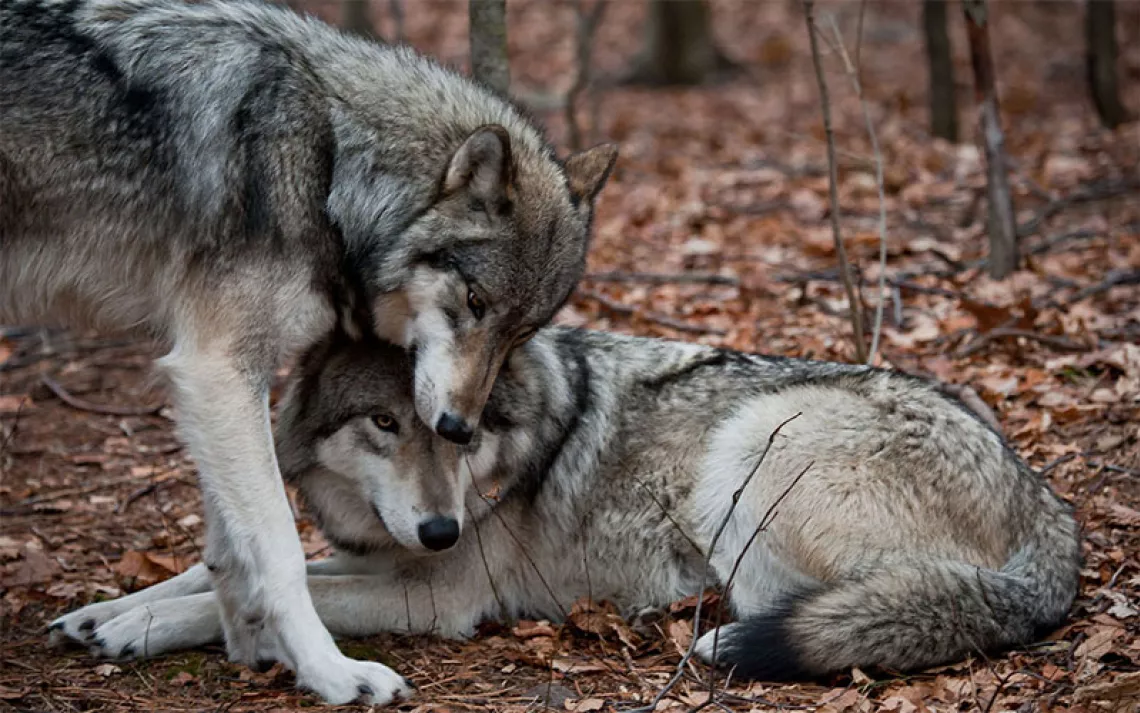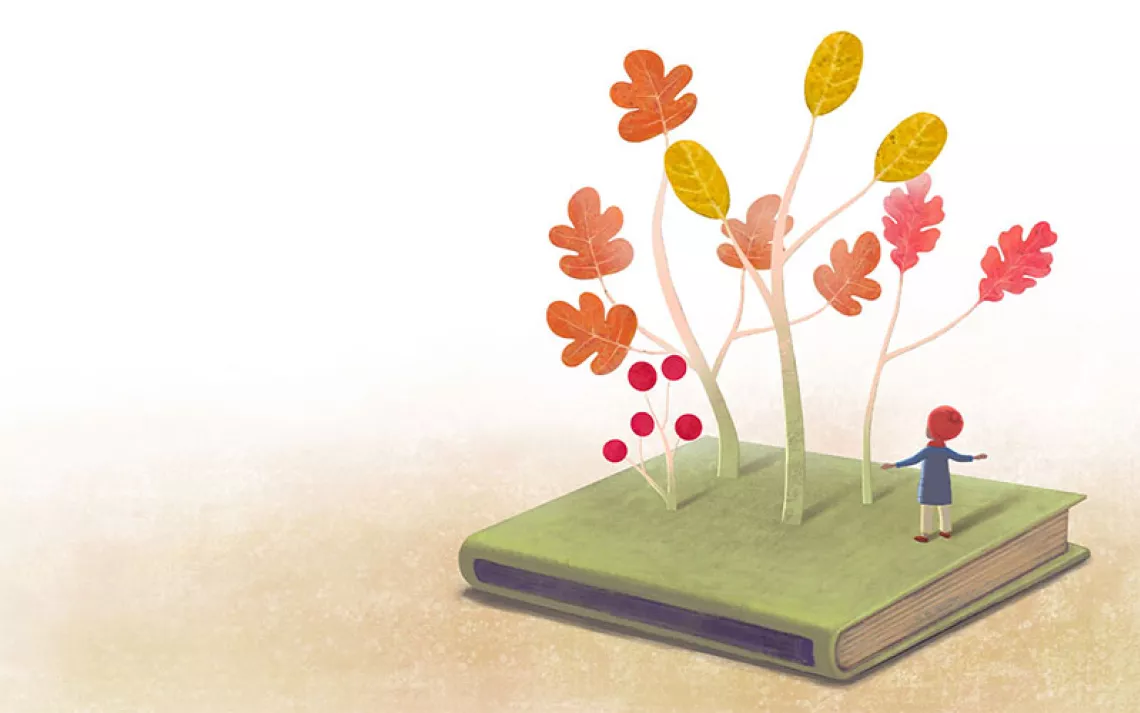Leopold's Gift
Today's movement to restore wild places began more than half a century ago in a shack in rural Wisconsin.
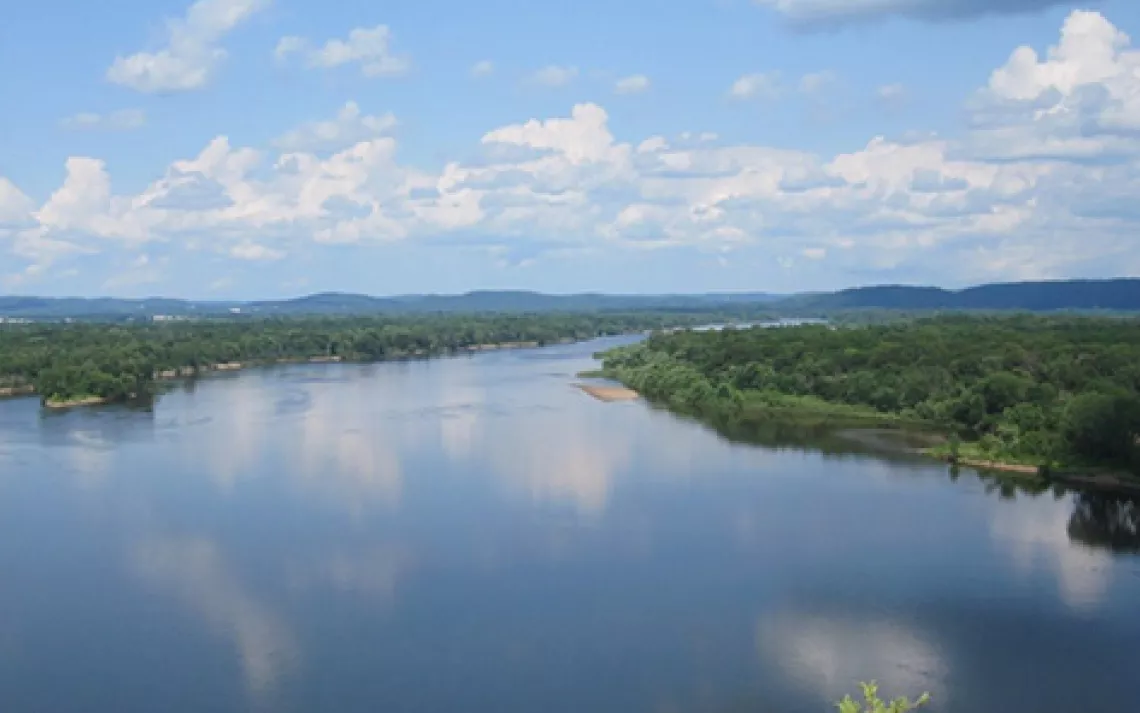
The Shack sits just above a sandy flood channel of the Wisconsin River, at a fork in the evolution of Americans' regard for the land. The windows-salvage glass, white-shuttered in dark, weathered walls-look out on a landscape formed toward the close of the last ice age, the "Wisconsin," when the sand of the "sand counties" was laid down in vast alluvial deposits. In one cataclysmic glacial outburst flood--a jökulhlaup, Icelanders call it--500 feet of sand were heaped up in places in just days, forcing the river to change course. It was down the broad, redirected stream of the Wisconsin, a few thousand years later, that much of the North Woods floated as logs.
Just beyond the Shack's woodpile, a low ridge rises, an old glacial moraine forested now with volunteer maples and transplanted pines. A short distance up the moraine, sunk in the golden leaf litter of the maples, is a pit lined by rounded stones. This was the basement of the man Aldo Leopold called "our predecessor the bootlegger, who hated this farm, skinned it of residual fertility, burned its farmhouse, threw it back into the lap of the county (with delinquent taxes to boot), and then disappeared among the landless anonymities of the Great Depression."
The pines growing everywhere on Leopold's 120 acres are living monuments to his experiments with restoration, symbolic of his ideas on stewardship. The pit of the bootlegger's basement is symbolic of our landowning ethic before Aldo came.
If the eco of ecology has literary cornerstones, they are Thoreau's Walden, George Perkins Marsh's Man and Nature, Rachel Carson's Silent Spring, and Leopold's A Sand County Almanac. The almanac is an epochal, seminal, ageless work. It is Bible still for land managers, Koran for those of us who work the soil where literature overlaps ecology, urtext for the ecological restoration movement.
The beginnings of ecological restoration-the first systematic attempt to reassemble disturbed ecosystems-came in 1934, when the University of Wisconsin at Madison, under Leopold's leadership, set out to build a collection of native ecological communities on abandoned farmland. (Leopold's ruined farm, bought the next year as a weekend retreat, became homework in this endeavor.) First with the help of the Civilian Conservation Corps, then by enlisting faculty and students, the university's arboretum restored 30 distinct systems-all the important plant communities native to the upper Midwest.
The restorationists quickly encountered a core problem of restoration: authenticity. Rehabilitation of land is one thing; recapitulation of ecosystems is another. The American landscape has been profoundly altered nearly everywhere by man. It is hard to know what nature intended in any particular place. "To keep every cog and wheel is the first precaution of intelligent tinkering," Leopold wrote. In land management that rule has been persistently violated, nature's parts scattered and lost.
The problem of authenticity, once its intractability was acknowledged, seemed to fade a bit. It dawned on the restorationists, as it dawns on most artists, scientists, mathematicians, that the end-product of their work-the restored prairie, marsh, or woodland-was no more important than the process of arriving there. The best way to learn how a marsh or prairie works, it turns out, is to attempt to restore it. The science of restoration ecology was born.
Restoration conferences and fairs proliferate now. Practitioners write essays on restoration as theater, on restoration theory, on restoration aesthetics, politics, ritual. Where once we had just one model-the University of Wisconsin Arboretum and the Leopold farm-now we have models everywhere: the 30-year-old experiment at Auroville, an oasis of millions of trees and sustainable farming in one of the most degraded regions of India. Nonsuch Island off Bermuda, restored by David Wingate in his successful effort to save a seabird, the Bermuda petrel. Wangari Maathai's Greenbelt Movement in Kenya, which has grown from the seven trees she planted in her backyard in 1977 to 20 million.
From the beginning there have been preservationists who have argued that restoration is premature. All available resources, they believe, should be devoted first to preservation of authenticity-of wilderness-and restoration can wait till later. Later has arrived. In the history of the environmental movement, the century or two of the Preservation Era will prove to be prologue: an introductory chapter, noble but brief. For the duration of human time on the planet-for whatever piece of eternity we have left here-restoration will be the great task.
If the meditations of A Sand County Almanac have an epicenter, it is the Shack, a converted chicken coop where Leopold and his family spent weekends on the farm. In October of last year, the 50th anniversary of the book's publication, photographer Michael Sewell and I took up residence. In our week on the place, we followed after Aldo, wandering all over the Leopold farm and the adjacent Leopold Reserve to view the fruits of his restoration labor. We found beaver-felled trees above a great marsh. We flushed wild turkeys from the margins of Levee Road. In the interior "uplands," as the locals like to call these imperceptible elevations, we surprised white-tailed deer.
The Wisconsin flows past the Leopold farm nearly as dark and tannic as Brazil's Rio Negro. I followed skunk tracks down the river beach, excavated the torn parchment of snapping-turtle eggs from little dunes at water's edge. Kneeling in the warm sand of the last ice age, piecing the shell fragments together like a puzzle, I tried to decide: hatched or eaten by predators? The Wisconsin is a big river. The great width of it opened up the sky, and the riverbank was the place for vistas. We saw kingfishers, killdeer, cormorants. A juvenile bald eagle watched us daily from its favorite snag on the far shore.
One evening we labored, stung by nettles and mosquitos, to set up Sewell's camera blind on Otter Pond in the great marsh. By morning light, the photographer, peering out, found the water wall-to-wall in geese. Otter Pond had no otter during Aldo's tenure. The last specimen of Lutra canadensis was extirpated before he came. Late in the 1980s, the species recolonized. We found otter runs and otter slides here and there in the great marsh. Radio-collared wolves now occasionally pass through, too. No one has seen wolves on Leopold land, but their signals have betrayed them.
If there was a pivotal moment in Aldo Leopold's life, as revealed in Sand County, it was his shooting of an Arizona wolf: "We reached the old wolf in time to watch a fierce green fire dying in her eyes. I realized then, and have known ever since, that there was something new to me in those eyes-something known only to her and to the mountain."
That fierce green fire glows again in the sand counties of Wisconsin.
Every evening, a half hour before sunset, I walked to the river to watch the flight of sandhill cranes. Geese flew by twilight, and shorebirds migrated at night, but cranes, in commuting from their daytime fields to the roosting beaches where they pass the night, always seemed to allow themselves plenty of light. They passed overhead in synchronized duos, threesomes, and squadrons. They honked the chortling, contrapuntal honk of cranes. "High horns, low horns, silence, and finally a pandemonium of trumpets, rattles, croaks, and cries," as Leopold wrote. On the far shore of the Wisconsin, still 200 feet above ground, they dropped their long legs in anticipation of landing. For Aldo Leopold, a musical man, the essence of cranes seems to have been their sound. For me, it was more visual: that moment at sunset when, high above Earth, their wings began to cup and the long legs dangled.
In 1935, when Leopold bought his farm, there were only 25 nesting pairs of sandhill cranes in Wisconsin. More than anything else, Leopold was a population biologist, and the crane became a special concern. "The ultimate value in these marshes is wildness, and the crane is wildness incarnate," he wrote. He corresponded with anyone in the state who knew anything of the bird: the landowner who had a breeding pair on his property, the Department of Natural Resources employee who had glimpsed one. Leopold was not optimistic. The "Marshland Elegy" chapter of Sand County ends with an epitaph to the sandhill crane:
"Some day, perhaps in the very process of our benefactions, perhaps in the fullness of geologic time, the last crane will trumpet his farewell and spiral skyward from the great marsh. High out of the clouds will fall the sound of hunting horns, the baying of the phantom pack, the tinkle of little bells, and then a silence never to be broken, unless perchance in some far pasture of the Milky Way."
Today there are 12,000 sandhill cranes in Wisconsin. Nothing would have cheered Leopold more. Restoration works. On the road to extinction, traffic travels both ways.
Wellington B. Huffaker IV led me along the moraine of the Leopold farm. Huffaker is a cherubic, bearded, thirtyish man who employs his full name mainly as a joke and goes by "Buddy." Formerly the ecologist for the Aldo Leopold Foundation, he had just been appointed executive director. "The job came ten years too early," he confessed of his promotion. "I wanted more dirt under my fingernails." It was the timeless complaint of the forester, the field archaeologist, the backcountry ranger. The outdoors is what draws these people in, but advancement means a desk. They all want to be "Buddy" a little while longer.
We reached the "good oak," or the site where that famous tree had stood. Sand County's February chapter, and its account of the felling of that tree, is the book's first tour de force. Leopold's crosscut saw, piling up "fragrant little chips of history," cuts back through 70 years of growth rings: the 1930s, the era of the bootlegger; 1925, the death of Wisconsin's last marten; 1908, the last cougar in Wisconsin, and so on. The oak beautifully encapsulates the history of land mismanagement in Wisconsin and the nation.
"Nina always says her father got the most out of a really insignificant tree," said Huffaker, gazing at the spot.
Nina Leopold Bradley, Aldo's first daughter, was right. From the good oak her father had got firewood, exercise, family teamwork, and a history lesson. Her observation, it struck me, applied by extension to the whole Leopold spread. Her father had got the most from a really insignificant farm, and in his success at this, the farm, like the oak, had gained enormous significance.
Huffaker led me on down the moraine. The gentle elevations of this feature, called "the Clay Hill" on the south side and "the Sand Hill" on the north, makes the spine of the Leopold property and the only real topography on it. All the drama in this flat part of Wisconsin, along the Wisconsin, happened back in the Wisconsin, when ice and j”kulhlaup shaped the country into its present bogs and ponds and moraines.
We stopped at the spot that inspired Leopold's short ode to the tiny plant draba. "Draba plucks no heartstrings," goes the fourth and final paragraph. "Its perfume, if there is any, is lost in the gusty winds. Its color is plain white. Its leaves wear a sensible woolly coat. Nothing eats it; it is too small. No poets sing of it. Some botanists once gave it a Latin name, and then forgot it. Altogether it is of no importance-just a small creature that does a small job quickly and well."
The best Leopold prose is like this; clear and plain, yet with an accent of idiosyncratic language and an undercurrent of private belief (for example, his use here of "creature" to include vegetation-as if plants too had spirits; his habit elsewhere of referring to tamarack, cottonwood, and dogwood as "he"-as if trees had gender). The story is pure Leopold: an insignificant plant leveraged, by his pen, into significance.
"There was a sand blow here," Huffaker said. "But the microclimate has changed. We haven't been able to find draba here for four years. It's in the mustard family. It likes it really hot and dry."
In order to maintain the open, sand-blown area, Leopold had refrained from planting pines, Huffaker said, but the trees had encroached anyway. Leopold's prolific pines stretched away in all directions. Trees have the effect of evening out topography, and these further diminished the minimal relief.
"Acts of creation are ordinarily reserved for gods and poets, but humbler folk may circumvent this restriction if they know how," Leopold wrote in Sand County. "To plant a pine, for example, one need be neither god nor poet; one need only own a shovel. By virtue of this curious loophole in the rules, any clodhopper may say: Let there be a tree-and there will be one.
"If his back be strong and his shovel sharp, there may eventually be ten thousand. And in the seventh year he may lean upon his shovel, and look upon his trees, and find them good." Leopold was too modest. He had planted far more than 10,000 pines. He planted, truth be told, too many.
"He planted forty-eight thousand pines in thirteen years here," Huffaker told me. "There are really way too many pines, compared to Wisconsin in pre-contact times." With a gesture at the surrounding forest, Huffaker gave me his State of the Farm address-short version. "In our management we need to go more to scrub oak and dry prairie," he said. "The prairie we do have is all appropriate. The floodplain area needs some work in addressing exotic species. Our main management decision is in the upland areas, which have thousands of pine trees. The question is whether those areas should be maintained in that character."
I asked Huffaker if he had any intuitions about what Leopold himself would have done. "That's always the question," he answered. "Leopold was working with the best knowledge available at the time; the best information on ecological restoration, though they didn't call it that yet. The whole concept of community ecology was just emerging. Now we know that pine trees aren't as good a wildlife habitat as we once thought they were. It's certainly logical that he would say, 'Clearcut these trees, and let's put it to prairie and savanna.' That's all fine and good. But this place is not for him. It is for everyone who comes with a piece of his story that they want to understand better."
Among recent pilgrims to the farm, Huffaker said, had been Forest Service Chief Michael Dombeck and Secretary of the Interior Bruce Babbitt. "It's really more a cultural landscape than an ecological landscape," he concluded.
My own guess is that Leopold, with good humor and little regret, would have felled much of his forest, but I took Huffaker's point. The trees were almost irrelevant. What prospered in this sandy soil were not Leopold's pines so much as his ideas.
Of the Leopold children, Nina has stayed closest to home. She and her husband, Charles Bradley, built their log house just down the road from the farm, on the Leopold Reserve, of trees that Nina and her parents and siblings had planted in the 1930s and '40s.
"We did a big thinning," Nina told me. "It needed to be done, and we were very glad to have the logs. We planted a lot of the trees too close together. You can see it especially going in the gate to the Shack. One reason was that the first year we planted was the end of a drought, and everything died. So the next year, instead of putting one seedling in the hole, we might put in two."
If Aldo slighted his prairie in favor of pines, then Nina and the other surviving children-Luna, Carl, and Estella-have learned from that mistake. Prairie restoration is a priority of the foundation they established in his name. In Nina's small attached greenhouse, bags of prairie seed await sowing: the small spheroids of prairie dropseed. The long-tailed, comet-shaped seeds of bottlebrush grass. The white parachutes of Canada hawkweed. The sunflowerlike seeds of silphium, the tall flower symbolic for her father of bison and prairie lost. Heath aster. Silky aster. Hoary vervain. Rosinweed. On the ceiling of the garage, rows of paper bags full of drying seeds hang on clothespins. The ceiling of Nina's sleeping porch, too, is a firmament of seed. Aldo's daughter sleeps with prairie-to-be at elbow and foot, and prairie-to-be overhead.
The Leopold Foundation collaborates with a neighboring outfit, the International Crane Foundation, in much of its prairie restoration. One October morning, on the path to a resurrected prairie on the ICF grounds a few miles from the farm, I joined several Leopold Foundation interns and a group of students from Germantown High School. We had come to harvest seed.
"We need seed! We got seed greed!" Jeb Barzen, director of field ecology for the ICF, told the Germantown students. "It's ridiculous how much seed we need."
Barzen told the kids that in the past 20 years students from their school had raised $14,000 toward prairie restoration. "Since 1976, Germantown High has been working on this prairie," he said. "We call it the Germantown Prairie. Some of the prairie you see grew from seeds that your predecessors at Germantown High collected. Less than one percent of Wisconsin's original prairie is left. Your contribution will be measurable in terms of that prairie."
The International Crane Foundation is dedicated to the preservation of the world's 15 species of crane, and to the defense of crane habitat. The ICF runs a captive breeding center for endangered cranes in nearby Baraboo and has embarked on restoration projects all over the world-in Keoladeo National Park in India, in the Han River estuary in Korea, in 15 provinces of China, in Muraviovka Park in Russia. The foundation had just launched an ambitious attempt to restore the Zambezi Delta in Mozambique, and had been at work for some time in Vietnam. "In the Mekong Delta, we work in a wetland restoration project on the Plain of Reeds," Barzen told me, "about fifteen thousand acres. But we're also dealing with issues over the whole Mekong River, and we're working in Cambodia, trying to establish wetland areas there."
That the ICF should have its facilities at Baraboo, in Aldo Leopold's backyard, is not entirely a coincidence, as Leopold scattered the seed of his ideas all over this part of Wisconsin. An ICF founder, George Archibald, is a Leopold fan and sits on the board of directors of the Aldo Leopold Foundation.
On reaching the prairie, we spread out in the tall grass. "Don't collect that turkey foot," Barzen warned of one species, also called big bluestem. "Just this Indian grass." Indian grass, Sorghastrum nutans, is a pleasure to collect. The species is big and aggressive, but its seed is soft, feathery, and easy to strip from the stem between thumb and forefinger.
A boy named Matt, wearing a gray sweatshirt, baseball cap, and what appeared to be his first beard, harvested his way up to a pair of girls ahead of me. Matt said something sly. "Get out, Matt-weed!" one of the girls replied. "Weed! Because you're annoying and you sprout up everywhere." Her tone was semi-affectionate, and Matt seemed to take it that way.
I was struck by how much these kids resembled the faces I had seen in old black-and-white group portraits of Civilian Conservation Corps crews working for the University of Wisconsin Arboretum, back in the Great Depression. The millennial number on the "Germantown Warhawks 00" jackets was different, and the hairstyles too, but the genome was the same. These were the grandchildren of those first restorationists. The science is now three generations old.
"Leopold said that when it came right down to it, there were two things that interested him: the relationship of people to the land, and the relationship of people to each other," Barzen said. "Restoration all comes down to working with people. The more I work in China and Vietnam, the more I realize very simple but important things. More often than not, when I'm frustrated because negotiations are going badly, it has very little to do with real disagreements. It has everything to do with bad communication; with differences in perception, differences in vision.
"How many times have you read the 'Land Ethic' or any of the rest of A Sand County Almanac?" Barzen asked. "Was it the same read every time? As you gain more perspective, more experience, you can understand the depth at which the book is written.
"I know exactly when I first read Sand County. I was in sixth grade. My dad gave it to me and said, 'Here, I think you might like this.' I still remember getting teased by kids in my class. I was reading the essay on January thaw, very early in the Almanac, where he talks about pink rabbit urine. All the sixth grade boys thought this was a pretty good joke. Pink rabbit urine. What that said to me, even at a young age, was, hey, there's a difference in the way people view things. I'm not seeing things the same way other people are seeing things.
"I didn't understand much about A Sand County Almanac then, but it had a huge influence on me. As it has every other time that I've read it."
A 50th-anniversary conference, "Building on Leopold's Legacy: Conservation for a New Century," was concluding in Madison when I arrived in Wisconsin. As it neared time for me to leave, a new symposium, the 28th Annual Conference on South Asia, was beginning in the same hotel. My sister, Barbara, a specialist in the Sherpas of Nepal, was attending this second meeting, and I drove into town for a visit. That evening surrounded by Himalayanists, I thought to inquire about Leopold's reputation on their turf-the regions at the top of the world.
"Leopold is held up again and again by everyone in community forestry," a high-altitude forester named Mark Baker said. "The idea of stewardship. The idea that landowners are imbued with responsibilities to the land and to each other. That comes from Leopold." Several others chimed in with similar sentiments. That Leopold should still inform and inspire scholars of the Himalaya, 50 years after his death, did not surprise me. Leopold seems to be fresh in the esteem of land specialists everywhere.
Not long before, at a restoration fair in San Francisco, I had wandered the stalls asking about Leopold. Among a few of the youngest restorationists, the name drew a blank, but most of the activists in the exposition hall smiled at hearing it. They knew Leopold's place in the history of their movement. Even the disclaimers were illuminating. I asked a Scot who had written a book on saving the Chaldonian forest about Leopold's reputation in Scotland.
"I would think he has less influence in Britain than over here," he answered. "I think of Aldo Leopold less as a restorationist than as an advocate of wilderness."
"Me too, I guess," I admitted. "But there really is a lot of restoration in him. Like that line about the importance of saving all the parts."
" 'The First Law of Intelligent Tinkering,' " he recited. Perhaps it's true that the Scots are not much influenced by Leopold, but this Scot knew Leopold by heart.
It's a game most pilgrims to the farm end up playing, I think: Where's Aldo? For me, Aldo did not seem to be lingering much around the Shack. The cigar box in the cupboard-the one containing his chickadee bands and handwritten bird notes-was certainly a reliquary of Aldo-ness. You felt his presence in handling it. A renewable ghost of Leopold jumped out each time you opened the lid. Otherwise, the building did not move me. The Shack seemed just a shack.
Mine was a minority opinion, I knew from the guestbook. "This is a holy place, and I think of it often as we fight today's battles to pass on our heritage," wrote Brock Evans of the Endangered Species Coalition. "I have often thought how wonderful it would be to come to this special place," wrote Mike Finley, superintendent of Yellowstone National Park. On November 2, 1997, a visitor named Guy Farb Paynette noted in the guestbook that he had measured the inside of the shack. By establishing the interior dimensions, Paynette had hoped, perhaps, to somehow quantify the magic in the place.
I sat in this chair, then that one, trying to call him up, as in a s‚ance. I cooked spaghetti in Aldo's frying pans. I stared into a fire we built on the very andirons where the good oak had blazed and warmed him. Nothing worked. Try as I might to evoke Aldo indoors, I failed. The Shack was Monticello, it was Lincoln's cabin, and yet I was not awed. I am the son of a great conservationist myself, and perhaps this has immunized me. Perhaps it has rendered me resistant to mythologizing.
Where I did find Aldo was outdoors.
Passing autumn blackberries, I would think "red lanterns," his metaphor for those scarlet leaves. Wading into the predawn mist on the great marsh, I sensed him very near. It was as if he and his dog had dematerialized in the fog just ahead. "Like the white ghost of a glacier," Aldo wrote of this mist, and this is exactly right. The field of mist is vaguely lenticular, like an ice sheet. Each day in the marsh amounts to an interglacial. At night a new ice age, the Leopoldian, advances over the bog-meadow, whitening everything but the tall stalks of common mullein, which rise above.
But mostly Aldo was up in the Wisconsin sky.
He was certainly in formation with the cranes. He was in their honks and trumpeting, and in the steep glide angle of crane descent. He was in the fast, shifting skeins of Canada geese. In the evening, wedge after wedge passed over the peak of the Shack, then over the Leopold forest, headed across the river. When the geese passed high, what you heard was the circularity of their honking. They were singing a round. When the geese passed low, you heard the whoosh of the wing-beats, too, and a sibilance at the wingtips. The wings made a contrail of sound through the sky, a windy, linear drone through which the geese wove the circular call-and-response of their honks.
I considered geese, so fast through the air, so formidable on the ground. The Romans, I remembered, had used geese as watchdogs. "Wings in geese-not so much to escape enemies as to chase the seasons," I wrote in my notebook.
The line pleased me inordinately. Closing the notebook, I began to wonder: Why had "chase the seasons" seemed so satisfactory? The effect was vaguely Aldoesque. Was that it? Was Sand County a standard I had internalized? To what extent had his rhythms and sensibilities become my own?
So that's where Aldo was. He was both everywhere and no longer here. Traces of him lingered around the farm, but for the most part he had flown. Of the migration of geese, he had written, "The waste corn of Illinois is carried through the clouds to the Arctic tundras, there to combine with the waste sunlight of a nightless June to grow goslings for all the lands between." Something similar had happened to Aldo. He had dispersed. He was loose in the world combining with things.
He was in my sentences, and in Mike Finley's directives on the management of Yellowstone's elk, and in Bruce Babbitt's speeches dedicating New Mexican wilderness. He sat in on Jeb Barzen's negotiations with Chinese villagers. He subtly guided discussions that Barzen's colleague, Rich Beilfuss, held with villagers in Mozambique. He was silent partner in dozens of little businesses like Bluestem Farm, in Baraboo, which sells native wildflowers and grasses ("nursery-grown Wisconsin ecotypes available all seasons").
He resided chiefly now in our collective consciousness, that dimensionless yet vast geography that preceded cyberspace and dwarfs it still. His influence remained strong in various projects along the Wisconsin, and now he was busy along the Mekong too. He was up in the rhododendron forests of the Himalaya. He was in Scotland's Chaldonian forest. He was out on the Zambezi Delta. He was down in the Plain of Reeds.
 The Magazine of The Sierra Club
The Magazine of The Sierra Club
